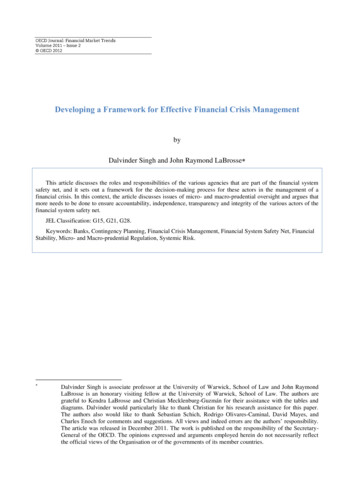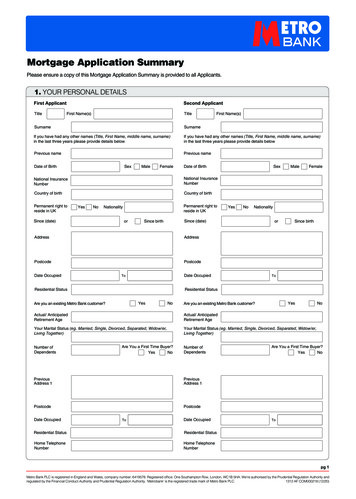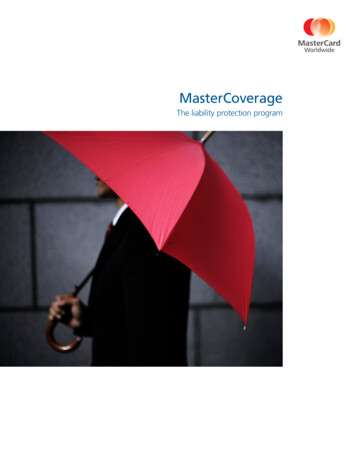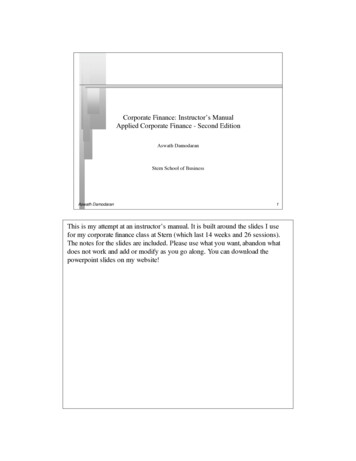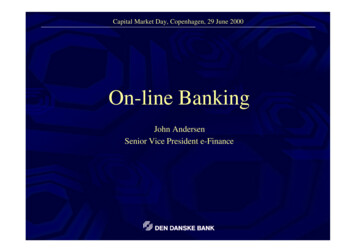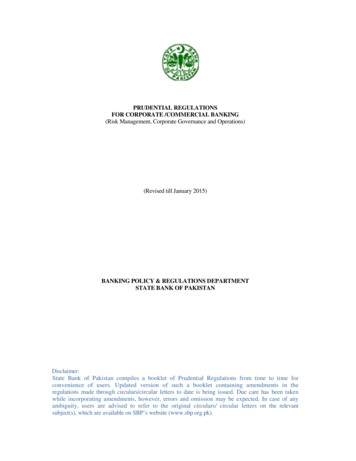
Transcription
PRUDENTIAL REGULATIONSFOR CORPORATE /COMMERCIAL BANKING(Risk Management, Corporate Governance and Operations)(Revised till January 2015)BANKING POLICY & REGULATIONS DEPARTMENTSTATE BANK OF PAKISTANDisclaimer:State Bank of Pakistan compiles a booklet of Prudential Regulations from time to time forconvenience of users. Updated version of such a booklet containing amendments in theregulations made through circulars/circular letters to date is being issued. Due care has been takenwhile incorporating amendments, however, errors and omission may be expected. In case of anyambiguity, users are advised to refer to the original circulars/ circular letters on the relevantsubject(s), which are available on SBP’s website (www.sbp.org.pk).
gulation R-1Exposure limits.09Regulation R-2Limit on exposure against contingent liabilities.09Regulation R-3Financial analysis & other conditions.10Regulation R-4Security and margin requirements11Regulation R-5Monitoring12Regulation R-6Exposure in shares and TFCs/Sukuk.13Regulation R-7Guarantees.14Regulation R-8Classification and provisioning for assets.15Regulation R-9Assuming obligations on behalf of NBFCs.17Regulation R-10Payment of dividend.17RISK MANAGEMENT (R)CORPORATE GOVERNANCE (G)Regulation G-1Corporate Governance/ Board of Directors and Management.17Regulation G-2Dealing with Directors, major shareholders and employees23of the banks/DFIs.Regulation G-3Contributions and donations for charitable, social, educational23and public welfare purposes.Regulation G-4Credit Rating.24OPERATIONS (O)Regulation O-1Undertaking of cash payments outside thebank’s24authorized place of business.Regulation O-2Window dressing.24Regulation O-3Reconciliation of inter-branch accounts and settlement of25suspense account entries.Regulation O-4Maintenance of assets in Pakistan.25Regulation O-5Foreign currency deposits under FE 25-199825Annexures27-51
PREFACEIn order to align the regulatory framework to changing business environment and the bestinternational practices, the State Bank of Pakistan, in consultation with stakeholders, has revised thePrudential Regulations on Risk Management, Corporate Governance and Operations for Corporate &Commercial Banking. The revised regulations aim to assist banks/DFIs in better addressing theirunique risk factors and dynamic environment by giving more discretion in business decisions. Theseregulations also describe minimum prudential benchmarks in critical risk areas to balance theconsiderations of financial stability of banks/DFIs vis-à-vis diversity and innovation.2) These Prudential Regulations do not supersede directives and instructions issued by the State Bankin respect of areas not covered under these regulations. Banks/DFIs that are compliant to the revisedor new limits as introduced in these regulations shall follow the same instantly. However, suchinstitutions which are in breach of these limits will have to achieve the compliance by 30-06-2015,unless otherwise specifically mentioned in the regulations.3) Banks/DFIs are advised to ensure meticulous compliance of these Regulations in letter and spirit.Any non-compliance or circumvention of the requirements will attract punitive action under theprovisions of the Banking Companies Ordinance, 1962.SHAUKAT ZAMANDirectorBanking Policy & Regulations Department
PART - ADEFINITIONSFor the purpose of these regulations: 1. Account Holder means a person who has opened any account with a bank directly or throughbranchless banking agent or is a holder of deposit/deposit certificate or any instrumentrepresenting deposit/placing of money with a bank/DFI or has borrowed money from thebank/DFI.2. Branchless Banking Agent means an agent providing banking services to the customersbank/DFI on behalf of the bank/DFI/MFBs under a valid agency agreement.of a3. Alternate Director means a person who has been designated by a director during his absence, as perprovisions of the sub-section (2) of section 192 of Companies Ordinance, 1984.4. Bank means a banking company as defined in the Banking Companies Ordinance, 1962.5. Borrower or Obligor means a person on whom a bank/DFI has taken any exposure during thecourse of business.6. Chief Executive Officer (CEO), in relation to bank/DFI means an individual who, subject to thecontrol and directions of the Board of Directors , is entrusted with the whole, or substantially thewhole, of the powers of management of the affairs of the bank/DFI occupying the position of ChiefExecutive Officer and include President, acting President, Managing Director, Country Head ofForeign bank, Executive assuming charge of the bank for interim period or by whatever name called,and whether under a contract of service or otherwise.7. Contingent Liability means:a) a possible obligation that arises from past events and whose existence will be confirmed only bythe occurrence or non- occurrence of one or more uncertain future events not wholly within thecontrol of the enterprise; orb) a present obligation that arises from past events but is not recognized because:i) it is not probable that an outflow of resources embodying economic benefits will be requiredto settle the obligation; orii) the amount of the obligation cannot be measured with sufficient reliability; and includesletters of credit, letters of guarantee, bid bonds/performance bonds, advance payment guarantees andunderwriting commitments.8. Control refers to an ownership directly or indirectly through subsidiaries, of more than one half ofvoting power of an enterprise.9. Corporate Card means credit card issued to the employees of an entity where the repayment is tobe made by the said entity.10. Derivative means a type of financial contract the value of which is determined by reference toone or more underlying assets or indices. The major categories of such contracts include forwards,futures, swaps and options. Derivative also includes structured financial products that have one or morecharacteristics of forwards, futures, swaps and options.11. DFI means Development Financial Institution and includes the Saudi Pak Industrial andAgricultural Investment Company Limited, Pak Kuwait Investment Company Limited, PakLibya Holding Company Limited, Pak Oman Investment Company (Pvt.) Limited, , House BuildingFinance Company Limited, Pak Brunei Investment Company Limited, PAIR Investment CompanyLimited, Pak-China Investment Company Limited, and any other financial institution notifiedunder Section 3-A of the Banking Companies Ordinance, 1962.12. Documents include vouchers, cheques, bills, pay-orders, promissory notes, securities forleases/advances and claims by or against the bank/DFI or other papers supporting entries in thebooks of a bank/DFI or any other document which establishes relationship between the bank/DFI and4
its customers.13. Director includes any person occupying the position of a director on the Board of a bank/DFI andincludes sponsor, nominee and alternate director or by whatever name called.14. Executive Director1 means a paid employee or executive in the concerned bank/DFIis also a member of the Board of Directors2.who15. Equity of the Bank/DFI includes paid-up capital in respect of ordinary shares, general reserves,balance in share premium account, reserve for issue of bonus shares, statutory reserves, and retainedearnings/accumulated losses as disclosed in latest annual audited financial statements. In case ofbranches of foreign banks operating in Pakistan, equity will mean capital maintained, free oflosses and provisions, under Section 13 of the Banking Companies Ordinance, 1962.For the purpose of Regulation R-1, reserve shall also include revaluation reserves on account offixed assets to the extent of 50% of their value. However, for this purpose assets must be prudentlyvalued by valuators on the panel of Pakistan Banks Association (PBA), fully taking into accountthe possibility of price fluctuations and forced sale value. Revaluation reserves reflecting thedifference between the book value and the market value will be eligible up to 50%.16. Exposure shall include:A) Financing Facilities whether fund based or non-fund based extended by a bank /DFIand include:i) Any form of financing facility extended or Bills purchased/discounted, Bills purchased /discounted on the guarantee of the person.ii) Credit facilities extended through Corporate Cards.iii) Any financing obligation undertaken on behalf of the person under a letter of credit including astand-by letter of credit, or similar instrument.iv) Loan repayment financial guarantees issued on behalf of the person.v) Any obligations undertaken on behalf of the person under any other guarantees includingunderwriting commitments.vi) Acceptance/endorsements made on account.vii) Any other liability assumed on behalf of the person to advancefunds pursuant to acontractual commitment.B) Subscription to or investment in shares, Participation Term Certificates, Term FinanceCertificates,Sukuk or any other Commercial Paper by whatever name calledissued orguaranteed by the persons.C) Exposure (Net open position) on account of derivative transactions allowed under FinancialDerivatives Business Regulations (FDBR) issued vide BSD Circular No. 17 dated November 26,2004. For the purpose of calculating exposure, the sanctioned limits, or outstanding, whichever arehigher, will be considered. However, in case of fully drawn term loans where there is no scope for redrawal of any portion of the sanctioned limit, bank/DFI may consider the outstanding asexposure.17. Family Member as defined in sub-section (ff) of section 5 of Banking Companies Ordinance 1962.18. Financial Institutions for the purpose of these regulations mean Banks, DevelopmentFinancial Institutions (DFIs) and NBFCs.19. Forced Sale Value (FSV) means the value which fully reflects the possibility of pricefluctuations and can currently be obtained by selling the mortgaged/pledged assets ina forced/distressed sale conditions.20. Government Securities shall include such types of Pak. Rupee obligations of the Federal1Amended vide BPRD Circular Letter No. 06 of 2012 dated March 21, 20125
Government or a Provincial Government or of a Corporation wholly owned or controlled,directly or indirectly, by the Federal Government or a Provincial Government and guaranteedby the Federal Government as the Federal Government may, by notification in the OfficialGazette, declare, to the extent determined from time to time, to be Government Securities.21. Group means persons, whether natural or juridical, if one of them or his dependent familymembers or its subsidiary, have control or hold substantial ownership interest (as defined in theseregulations) over the other.For the purpose of this definition:a) Subsidiary will have the same meaning as defined in section 3 of the Companies Ordinance, 1984i.e. a company or a body corporate shall deemed to be a subsidiary of another company if thatother company or body corporate directly or indirectly controls, beneficially owns or holds morethan 50% of its voting securities or otherwise has power to elect and appoint more than 50% of itsdirectors.b) Control refers to an ownership directly or indirectly through subsidiaries, of more than one half ofvoting power of an enterprise.c) Substantial ownership/affiliation means beneficial shareholding of more than 25% by aperson and/or by his dependent family members, which will include his/her spouse, dependent linealascendants and descendants and dependent brothers and sisters. However, shareholding in or bythe Government owned entities and financial institutions will not constitute substantialownership/affiliation, for the purpose of these regulations.22. Independent Director means such a person who is not linked directly or indirectly withbank/DFI or its sponsor or strategic shareholders. For the purpose of such determination, an"independent director" is a director who: Has not been employed by Bank /DFI within the last five years; Has not been an employee or affiliate of any present or former external auditor/consultant/legaladvisor of Bank/DFI within the last three years; Has not been an executive officer or employee of a subsidiary or associate companyofthebank/DFI or where Directors of the bank/DFI has substantial beneficial interest (20% or moreshareholding of director’s own or combined with family members); Has not been employed by a company of which an executive officer of Bank/DFI has been adirector within the last three years; Is not affiliated with a not-for-profit entity that received contributions from Bank/DFI exceeding of10 million or 2 percent of such charitable organization's consolidated gross revenues during thecurrent fiscal year or any of the last three completed fiscal years.(Note: An independent director shall submit a declaration for his/her independence to SBP at thetime of his/her appointment.)23. Key Executive1 means key executives of banks/DFIs and includes the following functionalresponsibilities for the present:a) Any executive, acting as second to CEO including Chief Operating Officer, Deputy ManagingDirector or by whatever name calledb) Chief Financial Officer/Head of Finance/Head of Accountsc) Head of Internal Auditd) Country Treasurere) Head of Credit/Risk Managementf) Head of Operationsg) Head of Complianceh) Head of Human Resourcei) Head of Information Technologyj) Head of Islamic Bankingk) Head of overseas operations of a bank at head office level 2l) Country Head/Regional Head (where a region is consisting of more than one foreign countries)1Inserted vide BPRD Circular No. 04 of 2007 dated April 23, 2007.2k) to n) inserted vide BPRD Circular No. 05 of 2009 dated March 05, 2009.6
m) CEO/Head of subsidiary banking company outside Pakistann) CEO of Joint Venture (where majority stake is with the bank incorporated in Pakistan & authorityto appoint CEO)The above list will be reviewed from time to time by SBP.24. Large Exposure means an exposure of 10% or more of a bank’s/DFI’s equity to a single obligoror a group.25. Liquid Assets are the assets which are readily convertible into cash without recourse to acourt of law and mean encashment/realizable value of government securities, bank deposits,certificates of deposit, shares of listed companies which are actively traded on the stock exchange, NITUnits, certificates of mutual funds, Certificates of Investment (COIs) issued by DFIs/NBFCs rated atleast ‘A’ by a credit rating agency on the approved panel of State Bank of Pakistan, listed TFCs ratedat least ‘A’ by a credit rating agency on the approved panel of State Bank of Pakistan and certificatesof asset management companies for which there is a book maker quoting daily offer and bidrates and there is active secondary market trading. These assets with appropriate margins should bein possession of the banks/DFIs with perfected lien.Guarantees issued by domestic banks/DFIs when received as collateral by banks/DFIs will betreated at par with liquid assets whereas, for guarantees issued by foreign banks, the issuingbanks’ rating, assigned either by Standard & Poors, Moody’s or Fitch-IBCA, Japan Credit RatingAgency (JCRA) should be ‘A’ and above or equivalent.The inter-branch indemnity/guarantee issued by the bank’s overseas branch in favor of its sisterbranch in Pakistan, would also be treated at par with liquid assets, provided the bank is rated ‘A’and above or equivalent either by Standard & Poors, Moody’s, Fitch-IBCA or Japan CreditRating Agency (JCRA). The indemnity for this purpose should be similar to a guarantee i.e.unconditional and demand in nature.26. Major Shareholder of a bank/DFI means any person holding 5% or more of the share capital ofa bank/DFI either individually or in concert with family members.27. Medium and Long Term Facilities mean facilities with maturities of more than one year andShort Term Facilities mean facilities with maturities up to one year.28. NBFC means Non-Banking Finance Company as defined in Section 282A of CompaniesOrdinance 1984 and includes Leasing Company, Housing Finance Company, Investment Bank,Discount House, Asset Management Company and a Venture Capital Company. For the purpose ofthese regulations Modaraba will also be considered as NBFC.29. Nominee Director means a person nominated on the board of a bank/DFI by sponsor(s),persons, company, institution etc. by virtue of his/their shareholding in a bank/DFI.30. PBA means Pakistan Banks Association.31. Person means and includes an individual, a Hindu undivided family, a firm, an association orbody of individuals whether incorporated or not, a company and every other juridical person.32. Recognized Rating Agency means rating agency either on the approved panel of State Bank ofPakistan or Standard & Poor’s, Moody’s, Fitch or Japan Credit Rating Agency (JCRA)33. Related Party in respect of a bank / DFI means:a.) Directors, CEO, sponsor shareholders, employees or any of their family members.b.) Any entity (proprietorship, firm, company or trust) in which a bank / DFI or any of the abovepersons are interested as director, proprietor, partner or as a shareholder holding 5% or more of paid-upcapital in that entity.c.) Any other entity which for its business acquisition or provision of services relies / depends to agreater extent on the bank/DFI i.e. major portion (50% or more) of its business (upstream ordownstream) is with the bank/DFI.d.) The relationship of the related party on the basis of Nominee Director appointed by7
Federal/Provincial government by virtue of their shareholding shall be excluded from this definition.However, it shall include personal/family business interests of such director.34. Secured means exposure backed by liquid assets, pledge stock, mortgage of land, plant,building, machinery or any other fixed assets, hypothecation of stock (inventory), trust receipt,assignment of receivable, lease rentals, and contact receivables but does not includehypothecation of household goods. The unsecured exposure will be considered as clean.35. Sponsor Shares1 mean 5% or more paid-up shares of a bank, acquired by a person(s)individually or in concert with his family members (including his spouse, lineal ascendants anddescendents and dependent brothers and sisters), group companies, subsidiaries,andaffiliates/associates. Such acquisition of shareholding will include all the shares acquiredby aforesaid person(s) including, interalia, through (a) as original subscriber/promoter of the bank;(b) subsequentright/bonusissues; (c)marketbasedacquisitiondeal; (d)reconstruction/restructuring of a bank carried out by SBP; (e) strategic sale through privatization(f) amalgamation of banking companies; or (g) any other mode of acquisition. All shares acquired bycommon shareholders, who are also sponsor shareholders, of amalgamating banking companies inamalgamation transaction shall be considered Sponsor Shares.36. Sponsor Shareholders2 mean all those shareholders of a bank holding sponsor shares.37. Sponsor Director3 means the member of the Board of Directors of a bank holding sponsor shares.38. Strategic Investment is an investment which a bank/DFI makes with the intention to hold it fora period of minimum 5 years.The following must be noted further in respect of strategic investment:a. The bank should mark strategic investment as such at the time of investment.b. If there are a series of purchases of stocks of a company, the minimum retention period of 5years shall be counted from the date of the last purchase.39. Substantial ownership/affiliation4 means beneficial shareholding of more than 20% by a personand/or by his dependent family members, which will include his/her spouse, dependent linealascendants and descendants and dependent brothers and sisters. However, shareholding in or bythe Government owned entities and financial institutions will not constitute substantialownership/affiliation, for the purpose of these regulations.40. Underwriting Commitments mean commitments given by commercial banks/DFIs to thelimited companies at the time of new issue of equity/debt instrument, that in case the proposed issueof equity/debt instrument is not fully subscribed, the un-subscribed portion will be taken up by them(commercial banks/DFIs).1Introduced vide BPRD Circular 4 of 2008 dated May 22, 2008.2Introduced vide BPRD Circular 4 of 2008 dated May 22, 2008.3Introduced vide BPRD Circular 4 of 2008 dated May 22, 2008.4Introduced vide BPRD Circular No. 04 of 2007 dated April 23, 2007.8
PART - BREGULATIONSREGULATION R-1EXPOSURE LIMITS1. Single Obligor/Group LimitExposure Limits for a single obligor, and obligor Group effective from 31-12-2013 and onward wouldbe as under:Effective date31-12-201330-06-2015Exposure limit as a % of bank’s/DFI’s equity(as disclosed in the latest audited financial statements)For single obligorFor obligor groupTotal (fund and nonTotal (fund andFund basedfund based) exposure Fund based limit non-fund based)limitlimitexposure limit25252525202025252. Related Party Exposure Limit:Maximum exposure limit of a bank/DFI to its related party or group of related parties would be asunder:Effective Date30-06-2015Total exposure limit as a % of bank’s/DFI’s equity (as disclosed inthe latest audited financial statements)For Single Related PartyFor Related Group7.5%15%The related party exposures shall be subject to the following:a) Loans given to employees under the Bank’s/DFI’s respective Human Resource policies dulyapproved by its BOD or Country Head (in case of branches of foreign banks) are excluded fromthis limit.b) Placement of funds of FE-25 deposits by the bank with its own branches/subsidiaries overseas shallalso be excluded from this limit.c) Bank’s/DFI’s investment in common shareholding of its subsidiaries shall not be countedtowards this exposure limit.d) Facilities extended to related parties should be at arm’s length basis and on normal terms &conditions applicable to other borrowers of the bank/DFI. Further, banks/DFIs shall ensure that thestandards are not compromised in such cases and market rates are used while extending facilities torelated parties.e) Banks shall also follow the requirements of section 24 of the Banking Companies Ordinance, 1962.3. For the purpose of para 1 and 2 above, banks/DFIs are required to follow the guidelines given atAnnexure-I. It is further clarified that the group will also cover SMEs, in cases where these are ownedby the same group.4. Large Exposure Limit:The aggregate amount of large exposures of a bank/DFI shall not, at any point in time, exceed 50% ofits total gross advances and investments (excluding investment in government securities and loanssecured against GOP guarantees). Large exposure limits shall not be applicable to investment ingovernment securities and loans secured against GOP guarantees.5. Different concentration limits may be assigned to different banks/DFIs by SBP based on theirsupervisory assessment.REGULATION R-2LIMIT ON EXPOSURE AGAINST CONTINGENT LIABILITIES1. Contingent liabilities of a bank/DFI shall not exceed at any point in time 10 times of its equity.9
2. The banks/DFIs that are Authorized Derivative Dealers in terms of BSD Circular No. 17 of 2004shall restrict their exposure to derivatives up to 5 times of their equity within overall limit ofcontingent liabilities.3. Following shall not constitute contingent liabilities for the purpose of this regulation:a) Bills for collection.b) Non-fund based exposure to the extent covered by cash/liquid assets.c) Letters of credit/guarantee where the payment is guaranteed by the State Bank ofPakistan/Federal Government or banks/DFIs rated at least ‘A’ by a recognized rating agency.d) Claims other than those related to provision of facilities (fund based or non-fund based) to thebanks’/DFIs’ constituents, where the probability of conversion of these claims into liabilities areremote.4.For the purpose of this regulation, weightage of 50% shall be given to bid/mobilizationadvance/performance bonds and 10% to forward foreign exchange contracts.REGULATION R-3FINANCIAL ANALYSIS & OTHER CONDITIONS1. Financial Analysis:a) At the time of allowing any exposure (including renewal, enhancement and rescheduling /restructuring) and annual review of long term facilities, Banks/DFIs shall, as a matter of rule, obtain acopy of financial statements relating to the business of every borrower. The financial statementsshould be duly audited by a practicing Chartered Accountant. In case of a borrower other than apublic company or a private company which is a subsidiary of a public company, financialstatements audited by a practicing Cost and Management Accountant are reckoned equallyacceptable. However, if the borrower is a public limited company and aggregate exposure from allBanks/DFIs exceeds Rs. 500 million, banks/DFIs should obtain the financial statements dulyaudited by a firm of Chartered Accountants which has received satisfactory rating under the QualityControl Review (QCR) Program of the Institute of Chartered Accountants of Pakistan.Subsequently, if the firm’s rating is downgraded in QCR program, then the financial statements ofsuch borrowers should be audited in the subsequent year by a firm having satisfactory rating underQCR.b) In case of public sector entities and allied departments / divisions of government which are notunder obligation to prepare and get audited their annual financials from accounting firms,banks/DFIs should devise criteria to obtain management accounts or some other mechanism beadopted to assess their financial position and performance.c) The Board of Directors of the bank/DFI shall approve a credit policy prescribing a minimumcurrent ratio and linkage between borrower’s equity and its total financing facilities from allfinancial institutions. The Credit Policy shall emphasize upon higher credit standards and provide fullguidance to the management about the above requirements for various categories of clients andcorresponding risk mitigants etc. acceptable to the bank/DFI. The policy shall also have explicitprovisions for circumstances or conditions under which the bank/DFI may extend financingfacilities that are in breach of these limits, should the bank decide to do so. The policy shall clearlyprovide approving authorities that would be responsible to allow exemptions in accordance with thepolicy. All such exceptions allowed shall be reported to the Board of Directors at least on quarterlybasis.d) Banks/DFIs are advised to properly assess the credit need of the borrower based on theirfinancial analysis and genuine credit requirements.2. Credit Report While considering proposals for any exposure (includingrenewal,enhancement and rescheduling/restructuring), banks/DFIs should give due weightage to the creditreport relating to the borrower and its group obtained from Credit Information Bureau (CIB) of StateBank of Pakistan. If the banks/DFIs decide to take exposure on defaulters, they shouldstrictly follow their risk management policies and credit approval criteria and properly recordreasons and justifications in the approval form. The banks/DFIs shall ensure that CIB report is notolder than two months at the time of approval of credit limits.10
3. Borrower Basic Fact Sheet Banks/DFIs are required to obtain Borrower’s Basic Fact Sheet(BBFS) as per format given at Annexure-II from their prospective borrowers at the time ofsanctioning fresh facility, or enhancement, renewal, rescheduling and restructuring of an existingfacility. However, if the Loan Application Form already contains all the information as required inBBFS, then no separate BBFS may be required.REGULATION R-4SECURITY AND MARGIN REQUIREMENTS1. Security Requirementsa) All exposures shall be adequately secured. However, banks/DFIs, in aggregate, may provide cleanfinancing facility in any form up to Rs 2,000,000/- (Rupees two million only) to any singleobligor. Financing facilities granted without securities including those granted against personalguarantees shall be deemed as ‘clean’ for the purpose of this regulation. Further, at the time ofgranting a clean facility, banks/DFIs shall obtain a written declaration to the effect that the borrower,has not availed of such facilities from other banks/DFIs so as to exceed the prescribed limit of Rs2,000,000/- in aggregate.b) In case of clean placements with banks/DFIs in Pakistan, single obligor limits given inPrudential Regulation R-1 shall be observed. However, for Banks/DFIs rated below ‘A-3’ (shortterm) or ‘BBB’ (long term) clean exposure limit given in para a) above shall be applicable.c) In case of Nostro Balances with financial institutions abroad, banks shall prudently set limits dulyapproved by their Board of Directors and that shall be exempt from the above limits.d) Banks/DFIs shall ensure that the aggregate exposure against all their clean facilities shall not, at anypoint in time, exceed the amount of their equity as disclosed in their latest audited financialstatements. However, following shall be excluded / exempted from aggregate limits for unsecured /clean exposure:(i) Facilities provided to finance the export of commodities eligible under Export Finance Schemebacked by LCs.(ii) Financing covered by the guarantee of Pakistan Export Finance Guarantee Agency up to theamount of guarantee.(iii) Loans/ advances given to the employees of the banks/ DFIs in accordance with theirentitlement / staff loan policy.(iv) Investment in COIs / interbank placements with NBFCs, provided the investee NBFC is at leastrated ‘A’ for long-term rating and ‘A2’ for short-term rating or equivalent by a recognized ratingagency.(v) Investment of banks/DFIs in subordinated and unsecured TFCs, issued by other banks/DFIs toraise Tier-II Capital as per State Bank of Pakistan’s instructions.e) Banks/DFIs will be free to decide about obtaining security/collateral against
Commercial Banking. The revised regulations aim to assist banks/DFIs in better addressing their . branchless banking agent or is a holder of deposit/deposit certificate or any instrument . books of a bank/DFI or any other document which establishes rel



